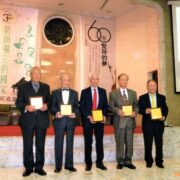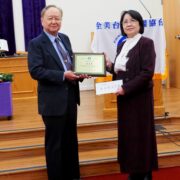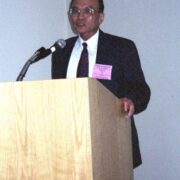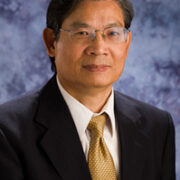The Call of Freedom – The Origin of 3F
Author: Tsu-Yi Jay Loo
Formosans’ Free Formosa (3F)
- The Philadelphia Five
The five founding members of 3F are Dr. Tom Yang, John Lin, Edward Chen, Echo Lin, and Tsu-Yi Jay Loo. Except for John, all of them are graduates of National Tainan First Senior High School, and except for Echo, all of them are Christians. Dr. Yang is the eldest, and Tsu-Yi Jay Loo is the youngest. After John and Edward graduated from National Taiwan University (NTU), they came to America to study International Relations at the University of Pennsylvania (UPenn) Graduate School. Echo was studying Organic Chemistry at the doctoral level, while Tsu-Yi had just arrived in Philadelphia for medical school.
Dr. Tom Yang is the oldest son of Tainan ophthalmologist Yun-lung Yang. After he graduated from the Jikei University School of Medicine in Tokyo in January of 1947, he returned to Taiwan and just in time to experience the 228 incident. After that, he worked as an attending physician of radiology at NTU College of Medicine. In 1953, Tom left to continue his studies in the United States, entering the UPenn Graduate School of Medicine in 1954 to study the most advanced medicine in the radiological field at that time. Tom rented a room in the UPenn neighborhood with John Lin and Edward Chen who were studying International Relations in the Department of Political Science at UPenn. Tom and John used to work at a church and a textile factory to help cover their living expenses.
John Lin was born and raised in a family of doctors in Taipei. In 1949, he served as the president of the NTU Student Council. Once, he was taken by a secret agent because he had protested against the military entering the university campus to arrest students. Luckily, the President of the University, Su-nien Fu, negotiated his release. After this dangerous occurrence, John was filled with hatred for Chiang Kai-shek’s regime and their tactics of ruling by terror.
Edward Chen was born in Penghu. His father, Dr. Chiung-yao Chen, practiced medicine in Tainan for many years. After Edward’s graduation from the Law Department at NTU, he was employed alongside John’s fiancée, Ms. Ching-tzu Tung (Grace Lin). It was through her that he was able to get John’s help in applying to UPenn. Edward likes to play the violin, having once organized a music troupe during his military service to celebrate Chiang Kai-shek’s birthday. After he arrived at UPenn, he often met with John, and his attitude towards the Kuomintang slowly shifted, eventually changing quite radically.
Echo Lin was born into a prominent Tainan family. His father, Chuan-fu Lin, was a well-known entrepreneur. Echo received his master’s degree from the University of New Mexico, and in 1955, he started his doctoral studies at UPenn in the Organic Chemistry department. Not long after, his girlfriend Dolores also moved from New Mexico to Philadelphia.
Tsu-Yi Jay Loo was raised in Tainan City. He went to Minato Primary School which was built during the Japanese rule and was located near the Tainan Canal. After World War II, he graduated from Chang-rung middle school and passed the test to be admitted to Provincial Tainan First Senior High School. His father, Mu-tung Loo, ran a business in Tainan for many years and was a very devout Christian. He served as an elder at Taiwan’s first church, KSK Church, for more than half a century.
Tsu-Yi graduated from Tainan First High School in 1951 and passed the test for admission to the College of Medicine at NTU. He attended NTU for less than three months, before moving to the U.S. in December of that year. At first, he attended Macalester College in St. Paul, the capital of Minnesota. Macalester is a small Presbyterian college and the alma mater of Reverend James Dickson, through whose introduction Tsu-Yi was admitted into the college. The next year, George Lu, a graduate of Taichung First Senior High School, also began his studies at Macalester College.
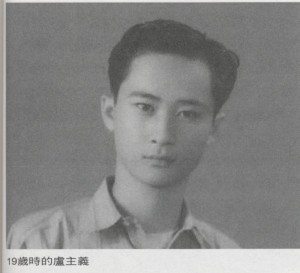 George’s father, Ching-yun Lu, had served as president of the Taichung City Chamber of Commerce and Industry and was also a Christian. Thus, George also attended Macalester College at the recommendation of Reverend Dickson, majoring in business.
George’s father, Ching-yun Lu, had served as president of the Taichung City Chamber of Commerce and Industry and was also a Christian. Thus, George also attended Macalester College at the recommendation of Reverend Dickson, majoring in business.
One day, Tsu-Yi was reading at the school library when George brought a book about Taiwan for him to read. It was American scholar Fred Rigg’s famous book (Formosa Under Chinese Nationalist Rule, Macmillan, 1952). The book describes in detail the military, political, and economic conditions in Taiwan during that time—objective information that was banned on the island of Taiwan back then. Tsu-Yi felt the information was fresh, and after reading the entire book in one sitting, his interest was piqued. He went to the library to look for more materials about Taiwan and ended up reading every book he could find. Of these materials, the two articles that George Kerr had published in the 1947 fall issue of Far Eastern Survey left the deepest impression. The first article recorded the causes and events of the 228 incident, and the second article, called “The March Massacre,” described how the Kuomintang army killed nearly 30,000 Taiwanese citizens, including the social elites in each major city. Kerr’s logical analysis of the Kuomintang’s corruption was very detailed and vivid, which had a profound effect of enlightening Tsu-Yi to this new political knowledge.
In the summer of 1955, Tsu-Yi worked part-time in Chicago. In September, he bid farewell to the many Taiwanese friends he had met in the Midwest and took the train to enroll at the Temple School of Medicine in Philadelphia.
This was his first time going to the East Coast, and there wasn’t a single Taiwanese person he knew there. So, before leaving Chicago, Tsu-Yi wrote a letter to a senior classmate from Tainan First Senior High School, brother Chin-rung Cheng, asking him to introduce him to other Taiwanese people living in Philadelphia. Thus, shortly after he arrived in Philadelphia, Dr. Tom Yang came to visit and took him to west Philadelphia to meet John, Edward, and Echo.
Tsu-Yi was very happy to meet these four Taiwanese friends, and that night they went to eat dinner together in Chinatown. After dinner, they walked together to the city center to see the City Hall, a huge and magnificent European style building. It was mid-autumn and the bright moonlight shone down on Market Street. Talking as they walked, everyone was very happy. John brought a Mid-Autumn Festival mooncake to give to Tsu-Yi as a first-meeting present. Tsu-Yi was a little surprised, and asked John why he was the only one who received a mooncake, to which John replied it was a gift to welcome his new younger brother.
Since that day, the five would frequently meet up on weekends to eat and chat. The topic of conversation was often the homeland that they all cared much for: Taiwan. It was the era of White Terror, and under the suppression of martial law, the Taiwanese people’s freedom of speech and thought were being deprived. Everyone was dissatisfied with the government’s tyrannical rule. John would frequently and severely criticize the Kuomintang, perhaps because he had once narrowly escaped the hands of Kuomintang agents.
There was a period of time where everyone had in-depth heart-to-heart conversations, getting to know each other and getting to understand each other’s family background. They shared insights about life and deepened their friendship; it was a very rare opportunity. After three or four months of discussions, Tsu-Yi began to feel that the repetition of these monotonous, emotional criticisms were having no effect, and that they needed to think more positively. One person asked, “what can we do?” Tsu-Yi replied: “we can advocate for Taiwan independence.” In response, John and Edward raised a number of questions. For example: didn’t the Cairo Declaration already transfer Taiwan from Japan into China’s hands? Aren’t Taiwanese people Chinese? Taiwan is so small; can it support itself economically?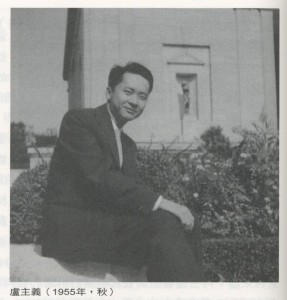
Luckily, Tsu-Yi had already read a lot of books about Taiwan and could answer each of these questions one-by-one. Though there were still a number of debates following this occasion, in the end, everyone came to a consensus, a process over which Dr. Tom Yang had great influence. When Thomas Liao created the Republic of Taiwan Provisional Government in Tokyo in February 1956, Tom’s cousin, Dr. Chen-nan Wu, became the Vice-President. So Tom was not at all new to the concept of Taiwan independence. Of the Philadelphia Five, Tom was the oldest, and as a devout Christian, Tom had won everyone’s respect with his honesty. Tsu-Yi was the youngest, a medical student, and rather new to political issues. John and Edward were majoring in politics and international relations, and so, though they yearned for Taiwan independence, they were always a little skeptical. Sometimes when they were fiercely debating and neither side would give in to the other, Tom would just say “Tsu-Yi is right,” and resolve the conflict.
- 3F’s Call to Action
In December of 1955, Tsu-Yi wrote a letter to the New York Times saying that the Kuomintang had imposed a dictatorship in Taiwan and suppressed the people. He wrote that if the United States did not help the Taiwanese people escape the Kuomintang’s tyrannical rule, Taiwan could soon be in danger of falling into the hands of the Communists. When this letter was published, John and Edward were especially excited. It turned out that they too had written letters many times before, but none had ever been published. The publication of Tsu-Yi’s letter showed that as long the Taiwanese’s suffering could be explained clearly, Americans would support Taiwanese. After this, Tsu-Yi proposed the formation of Formosans’ Free Formosa. 3F had two missions: (1) to resist all authoritarian governments, including the Kuomintang and the People’s Republic of China; (2) to establish Taiwan as an independent and democratic state. Their goals included: (1) regularly distribute newsletters to Taiwanese students studying in the U.S. to promote the idea of Taiwan independence and to recruit members; (2) lobby members of the U.S. Congress; (3) mail papers about topics related to Taiwan to members of the U.S. Congress, university libraries, and the mass media. By the end of that year, Tom, Edward, and the others successively agreed with the concept of 3F, and they decided to formally establish 3F on New Year’s Day, 1956.
The assignment of 3F’s work is as follows: Tsu-Yi was responsible for editing newsletters and fundraising. He was also responsible for recruiting new members because he knew more Taiwanese students on the East Coast and in the Midwest. Edward had an American girlfriend named Maxine (she later married him) who was a professional secretary, so the task of typing up the English manuscripts was handed over to her. At that time, publications were hand-printed sheet by sheet on a mimeograph, bound, and then mailed. Others helped out with this tedious work, including Echo’s girlfriend, Dolores. The workers would often toil past midnight just to be able to mail the newsletters out on time.
3F’s first newsletter was published in January 1956, announcing the establishment of 3F. At the beginning of the open letter, Tsu-Yi wrote: “This is a century of awakening, a century of revolution.” Since 1945, colonies around the world have one by one declared independence. We too should act boldly, proving that our Taiwanese identity is something worthy of pride. “We are not willing to surrender ourselves to the rule of a violent and militarized minority forever.” From the beginning of 1956 until 1957, 3F published a total of 11 newsletters, with contents that covered a brief history of Taiwan, analyses of the 228 incident, and how American and British political elites should approach the topic of Taiwan’s future. Articles like “We are not alone” were collaboratively written by Tsu-Yi, Edward, and John, but Tsu-Yi wrote more analytical works than the others.
- Petition Letter to the UN
In the spring of 1956, Tsu-Yi wrote a letter under 3F’s name to Thomas Liao in Tokyo, introducing the activities of 3F and expressing their willingness to cooperate with the Formosa Democratic Independence Party (FDIP), led by Liao. After that, 3F and Liao corresponded frequently through letters. At the time, the FDIP’s strategy was to demand for the UN to take control of Taiwan, and after a period of transition, hold a referendum to allow the citizens to decide the future of Taiwan. To do this, Liao asked that 3F designate two people to act as special envoys of the Provisional Government. The envoys’ job would be to personally negotiate with the UN and U.S., and to send a petition in English to the Secretary General of the UN (Dag Hammarskjold).
After finishing his first year of medical school, Tsu-Yi went west to spend the summer of 1956 in Montana, working with the National Forest Service. During the nights and weekends, he began to consider giving up medicine and switching his focus to the field of political economy. The work required for medical school was very heavy, and if he continued to study medicine, there would be no way for him to continue participating in the Taiwan independence movement. In Taiwan, the most outstanding and talented people are concentrated in the medical field; few are interested in fields related to the governing of a nation: macroeconomics and politics. If Taiwan independence should be achieved one day, how would the nation be governed? After much deliberation, Tsu-Yi decided that after finishing up his summer work, he’d move from Philadelphia to Minneapolis to study political science and economics at the University of Minnesota. Since he’d begun medical school without receiving his bachelor’s degree, he received his B.A. in December of 1957 (Bachelor of Arts in Political Science, summa cum laude).
In the fall of 1957, Tsu-Yi had to take 18 to 21 credits per quarter (the average student only takes 15 to 16). He also had to work 20 hours in the university cafeteria and keep in contact with his fellow 3F members in Philadelphia so that they could continue to publish the 3F newsletter. Tsu-Yi was extremely busy every day; he not only had to manage a lot of schoolwork and his part-time job, he also had to work on publicizing the fight for Taiwan independence. He drafted and typed up the petition to the UN, entrusted to him by Thomas Liao, in a single night. By the time he had completed the 3,000-word letter, dawn had nearly broken. 3F sent the letter under the pseudonym Peter Ong as representative of the Provisional Government, requesting an interview with the UN Secretary General. A UN lawyer wrote back on behalf of the Secretary General on November 24th, saying that since the “Republic of Taiwan Provisional Government” was not recognized by any of the Member States of the UN, it would be inappropriate for the Secretary General to grant a meeting to representatives of the Provisional Government.
- The FBI Investigation of 3F
On January 31st, 1957, Mr. Watson, an FBI investigator, visited George Lu, who was studying at Macalester College. Watson was a lawyer looking for information about 3F. Who was publishing the newsletter? Where was the headquarters? What was the purpose of 3F? Where was funding coming from? How were Thomas Liao and 3F related? George replied that he could only explain the purpose of 3F, and that he could only answer the other questions after discussing with a friend. The following day, George and Tsu-Yi went to the Minneapolis FBI office to visit Watson. After that, the two of them continued to meet with Watson once every two or three weeks. During that era of the Red Scare, the FBI was most concerned about the U.S. domestic security. After three or four months of back and forth, Tsu-Yi voluntarily provided Watson with 3F publicity materials which explained Taiwan’s White Terror repression. He was finally able to persuade Watson, making him understand that 3F advocated democracy and was an anti-communist organization. However, after the FBI transferred the information to the Department of Justice, the Department of Justice decided in February 1958 that it believed 3F was an agent of the Provisional Government, and that the petition to the UN was written in violation of the Foreign Agents Registration Act. Thus, the members of 3F registered with the Department of Justice to resolve this case, and fortunately, they were able to stay united and the work of 3F wasn’t interrupted by the FBI’s interference.
Excerpt from Self-awareness and Identity – Compendium of Overseas Taiwanese Movements from 1950~1990 (June 2005)
Translated from 85. 自由的號角-3F之起源/盧主義/2015/01


